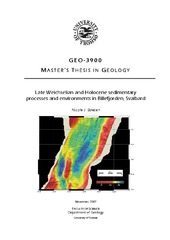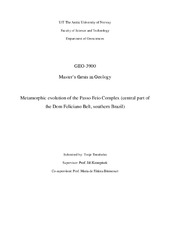Blar i tittel Mastergradsoppgaver i geologi
Viser treff 123-142 av 272
-
Late Cenozoic development of the mid-Norwegian continental margin – a study of the Naust Formation based on 3D-seismic data
(Master thesis; Mastergradsoppgave, 2020-06-15)The late Cenozoic evolution of the outer continental shelf and slope on the northern part of the mid-Norwegian margin is studied using 3D seismic data. The late Cenozoic stratigraphy is subdivided into four main seismic units: unit A (oldest) to D and correlated to the established stratigraphic framework of the Naust Formation, where the oldest unit in this study correlates to the upper part of Naust ... -
Late Cenozoic erosion in the SW Barents Sea, and its influence on salt movement
(Master thesis; Mastergradsoppgave, 2019-05-15)The late Cenozoic evolution of the southwestern Barents Sea shelf includes periods of uplift, erosion and glaciations. This part of the stratigraphy has been studied using 2D and 3D seismic data, with emphasis on the interplay between uplift, erosion and glaciations and salt movement. The study area comprises the Svalis, Samson and Norvarg domes and the Nordkapp Basin, where halokinesis has been a ... -
Late Cenozoic paleoenvironments in the Veslemøy High area, SW Barents Sea based on 3D- and 2D- seismic data
(Master thesis; Mastergradsoppgave, 2009-05)The aim of this master thesis has been to interpret the Late Cenozoic paleo-environments and the sedimentary processes in the Veslemøy High area, southwestern Barents Sea. Six seismic units and eight seismic unconformities, including the seafloor, are identified in the study area and correlated with previous work in the Sørvestnaget Basin. Submarine channels with a downslope (E-W) orientation suggest ... -
Late Miocene Ice Rafting in the Iceland Sea. Evidence from coarse fraction analysis of ODP Site 907
(Master thesis; Mastergradsoppgave, 2018-05-15)A high-resolution sedimentary record from ODP Leg 151 Hole 907A has been investigated with sedimentological and geochemical methods to study the paleoenvironmental evolution of the Iceland Sea over a 1-Myr time interval in the Late Miocene. Climate deterioration characterizes the Neogene period, culminating in a transition to bipolar glaciations in the Late Pliocene (Thiede and Myhre, 1996). Ice ... -
The Late Paleozoic development of the Ottar basin from seismic 3D interpretation
(Master thesis; Mastergradsoppgave, 2018-05-15)The Late Paleozoic sedimentary environments of the Ottar basin in the SW Barents Sea was studied using five 3D seismic surveys. By the use of seismic stratigraphic analysis and correlation to wells located in close proximity to the study area, the Paleozoic succession has been subdivided into 4 main units: Billefjorden Group (Late Devonian – Mid Carboniferous), Gipsdalen Group (Mid Carboniferous – ... -
Late Paleozoic-Cenozoic fault correlation and characterization of fault rocks in western Troms, North Norway
(Master thesis; Mastergradsoppgave, 2013-05-29)The present work focuses on the mapping and description of onshore brittle fault zones on the SW Barents Sea Margin, within gneisses and granitic intrusions belonging to the West Troms Basement Complex. The description of the brittle structures includes the geometry, kinematics and fault rock characteristics, using DEM satellite imaging, structural field work and a microstructural analysis of the ... -
Late Quaternary tephra stratigraphy and paleoenvironmental reconstruction based on lake sediments from North and Northeast Iceland
(Mastergradsoppgave; Master thesis, 2020-07-12)Due to Iceland’s position in the middle of the North Atlantic, the island is highly sensitive to oceanic and atmospheric fluctuations, which lead to changes in the environment. These fluctuating environmental conditions in addition to Iceland’s high volcanic activity make it a strategic study area for paleoenvironmental and tephra studies. Lake sediments contain information about such past climate ... -
Late Triassic channel systems at the Loppa High, SW Barents Sea
(Master thesis; Mastergradsoppgave, 2015-12-23)The study is based on the 3D seismic dataset (LN09M01). The study area is located in the southwest Barents Sea, south-western flank of the Loppa High. In the SW Barents Sea, the Middle to Late Triassic interval incorporates relatively thick and widespread fluvial system in the Snadd Formation, which is characterized by distinctive abundance of channel bodies of varying shape and extend. During ... -
Late Weichselian and Holocene glacier dynamics and sedimentary processes in and north of the Wijdefjorden-Austfjorden fjord system, north Spitsbergen
(Master thesis; Mastergradsoppgave, 2019-05-16)Multi-proxy analyses (lithostratigraphy, physical properties, XRF core scanning, and grain size analysis) of five sediment cores and high resolution seismic (chirp) data were integrated to reconstruct the Late Weichselian and Holocene sedimentary environments and glacial history in and on the shelf north of Wijdefjorden. Three acoustic units (U1-U3) correlating with three lithostratigraphic units ... -
Late Weichselian and Holocene sedimentary processes and glacier dynamics in Woodfjorden, Bockfjorden and Liefdefjorden, North Spitsbergen
(Master thesis; Mastergradsoppgave, 2014-05-31)Abstract Swath bathymetry, high resolution seismic data and sediment cores were analyzed to reconstruct the Late Weichselian and Holocene sedimentary environments and glacier dynamics in Woodfjorden, Bockfjorden and Liefdefjorden, north Spitsbergen. Mega-scale glacial-lineations provide evidence of fast-flowing grounded ice draining the northwestern parts of the Late Weichselian Svalbard Barents ... -
Late Weichselian and Holocene sedimentary processes and environments in Billefjorden, Svalbard
(Master thesis; Mastergradsoppgave, 2007-11)Three sediment cores, swath multibeam bathymetry data and high-resolution seismic data from Billefjorden, Svalbard have been analysed for a better understanding of the Late Weichselian and Holocene glacier activity as well as sedimentary process and glacigenic deposits in the fjord. The data reveal that glacial linear features were generated in the central part of Billefjorden while it was filled ... -
Metamorf utvikling av Skagen-eklogitt, Flakstadøy, Lofoten
(Master thesis; Mastergradsoppgave, 2011-05)Bergartsprøver fra Skagen på Flakstadøy, Lofoten er mikroskopert, analysert ved mikrosonde og gjort geotermobarometriske estimat på, alt for å kunne fortelle om den metamorfe utviklingen for bergartene. Resultatene forteller om en polymorf utviklingshistorie av de proterozoiske bergartene som Flakstadøy er bygd opp av. Flere eklogittforekomster er funnet på øyen, noe som ikke er så overraskende da ... -
Metamorphic conditions in the Coastal-Punta del Este Terrane of the Kaoko-Dom Feliciano Belt in Namibia and Uruguay
(Master thesis; Mastergradsoppgave, 2016-06-24)The metasediementary rocks of the Coastal Terrane in the Kaoko Belt (Namibia) and the meta-igneous rocks of the Punta del Este-Terrane in the Dom Feliciano Belt (Uruguay) both share one high-grade metamorphic event at approximately the same time of c. 650-630 Ma. Metamorphic conditions of this high-grade event were estimated in four samples from the Punta del Este Terrane and two samples from ... -
Metamorphic evolution in external zones of the Dom Feliciano-Kaoko orogenic system. Examples from the Brusque Metamorphic Complex, Dom Feliciano Belt (Brazil) and the Central Kaoko Zone, Kaoko Belt (Namibia)
(Master thesis; Mastergradsoppgave, 2018-05-15)The Brusque Metamorphic Complex in the Dom Feliciano Belt (Brazil) and the Central Kaoko Zone in the Kaoko Belt (Namibia) represent foreland fold- and thrust belts in external parts of the northern Dom Feliciano-Kaoko orogenic system. Petrographic and field observations of metapelitic samples from the Brusque Metamorphic Complex suggests that the western part of the complex can be subdivided into ... -
Metamorphic evolution of the Passo Feio Complex (central part of the Dom Feliciano Belt, southern Brazil)
(Master thesis; Mastergradsoppgave, 2019-05-15)The Passo Feio Complex is considered as a part of the São Gabriel Terrane, located to the west of the Dom Feliciano Belt in the state of Rio Grande do Sul (Brazil), but shows numerous similarities with the easterly exposed Porongos Metamorphic Complex which is a part of the Schist Belt in that area. P-T phase equilibrium modelling of metamorphosed sedimentary rocks from the Passo Feio Complex was ... -
Microstructural and metamoprhic study in rocks of the Seiland Igneous Province between Langfjord and Øksfjord, Alta kommune, Northern Norway
(Master thesis; Mastergradsoppgave, 2010-11-22)The Seiland Igneous Province (SIP) is situated in western Finnmark, Northern Norway. The SIP comprises a suite of mainly gabbroic plutons, with ultramafic, syenitic and felsic intrusions. The origin of the region has been interpreted in different ways and several tectonic models have been proposed. Many different ideas have been suggested about the metamorphic, magmatic and deformation history. New ... -
Microstructural changes during melt-assisted modification of quartzofeldspatic rocks. An example from the Eger Complex, North-Western Bohemian Massif
(Master thesis; Mastergradsoppgave, 2017-05-15)The Eger Complex is situated in the Saxothuringian domain at the western margin of Bohemian Massif (Czech Republic). Migmatitic orthogneisses associated with granofelses and high-pressure felsic granulites make up the majority of the complex, which is interpreted as an upper crystalline nappe exhumed from underneath the fore-arc Teplá-Barrandian domain during the Variscan orogeny. Studies conducted ... -
Microstructural investigation of shear localization in the Ersfjord granite, Kvaløya, Troms: A case study of kinematics, deformation mechanisms and fabric relationships
(Master thesis; Mastergradsoppgave, 2014-05-15)The present “case study” deals with Paleozoic-Mesozoic oblique-dextral strike-slip shear zones situated within the Ersfjord granite (1,79 Ga), that are believed to give valuable insight into fault- and fluid flow mechanics from the brittle-ductile transition zone. Mesoscopic observations combined with microstructural evidence and geochronology suggests that Late Carbonifereous-Early Triassic fault ... -
Mid Miocene – Early Pliocene depositional environment on the northern part of the Mid-Norwegian Continental Shelf
(Master thesis; Mastergradsoppgave, 2016-05-15)Based on the study of 2D seismic data, this thesis have focused on the depositional environment during the deposition of the Kai formation (Mid-Miocene – Early Pliocene) on the Mid-Norwegian continental margin, in order to increase our knowledge of the evolution of the paleo-environment in the time-period right before the development of the large Northern Hemisphere ice sheets. Based on a seismic ... -
Mineralogy,geochemistry and ore potential of an ultramafic rock from the Kvaløya Island.
(Master thesis; Mastergradsoppgave, 2013-12-29)A low-grade metamorphic ultramafic rock at the Kvaløya Island, North Norway, shows Ni content up to 2 500 ppm. Olivine is absent from the rock, and Ni is principally bonded in pentlandite, violarite and millerite. Among other sulphide minerals found in the rock are pyrite, pyrrhotite, chalcopyrite, sphalerite, galena and heazlewoodite (?). Two generations of pyrite are observed in the rock. Second ...


 English
English norsk
norsk


















